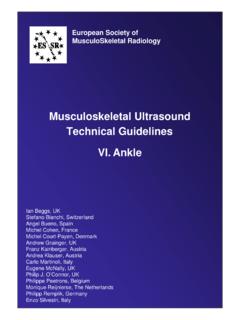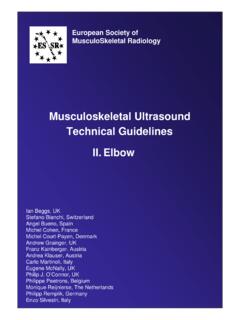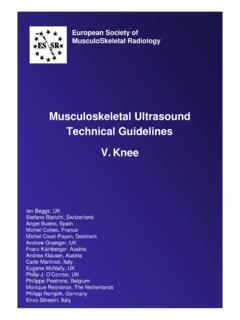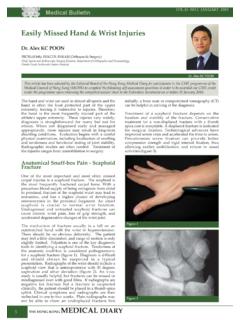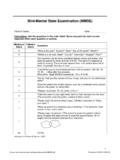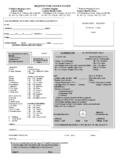Transcription of Musculoskeletal Ultrasound Technical Guidelines III
1 European Society of Musculoskeletal RadiologyMusculoskeletal UltrasoundTechnical GuidelinesIII. WristIan Beggs, UKStefano Bianchi, SwitzerlandAngel Bueno, SpainMichel Cohen, FranceMichel Court-Payen, DenmarkAndrew Grainger, UKFranz Kainberger, AustriaAndrea Klauser, AustriaCarlo Martinoli, Italy Eugene McNally, UKPhilip J. O Connor, UKPhilippe Peetrons, BelgiumMonique Reijnierse, The NetherlandsPhilipp Remplik, GermanyEnzo Silvestri, ItalyThe standard US examination of the wrist begins with evaluation of its dorsal aspect, followed by the palmar one. Depending on the specific clinical presentation, US images can be obtained in different position of the wrist (flexion and extension, radial and ulnar deviation, pronation and supination), with the patient seated in front of the examiner.
2 Note1 Place the transducer on a transverse plane over the dorsal aspect of the wrist to allow proper identification of the extensor tendons. In general, one should first recognize a given tendon and then follow it on short-axis planes down to the distal insertion. Long-axis US images of the extensor tendons are less useful: they may help to evaluate the integrity of tendons and assess their dynamic motion in detail. Dynamic scanning of the extensor tendons can be performed by placing the hand on a gel tube with the fingers hanging outside its edge to allow easy fingers the patient s wrist halfway between pronation and supination, place the probe over the lateral aspect of the radial styloid to examine the first compartment of the extensor tendons - abductor pollicis longus (ventral) and extensor pollicis brevis (dorsal).
3 Legend: APL, abductor pollicis longus; EPB, extensor pollicis brevis; ECRL, extensor carpi radialis longus; EPCB, extensor carpi radialis brevis; EPL, extensor pollicis longus; EIP, extensor indicis proprius; EDC, extensor digitorum longus; EDQ, extensor digiti quinti proprius; ECU, extensor carpi ulnaris2 Check the retinaculum and note the possible occurrence of a vertical septum that splits the compartment in two distinct spaces. Follow the abductor pollicis longus distally over the scaphoid to assess possible accessory tendons. Legend: APL, abductor pollicis longus; arrowheads, retinaculum; EPB, extensor pollicis brevis : 3 Look at the radial artery and the sensory branch of the radial nerve, the first encroaching deep, the second superficial to the first compartment.
4 Scanning from proximal to distal, note the radial nerve and its branches snapping from ventral to dorsal over these the palm facing the examination table, shift the probe medially on transverse planes to depict the second compartment - extensor carpi radialis longus and extensor carpi radialis brevis tendons. Sweep the probe cranially over these tendons up to demonstrate the abductor pollicis longus and extensor pollicis brevis muscles that encroach superficial to them at the distal forearm (intersection) to reach the first Legend: A, radial artery; APL, abductor pollicis longus tendon; arrow, radial nerve; asterisks, tendinous slips of the abductor pollicis longus; EPB, extensor pollicis brevis tendon; v, cephalic vein ** !
5 " " " " Legend: ECRL, extensor carpi radialis longus tendon; ECRB, extensor carpi radialis brevis tendon; arrows, bulk of the abductor longus and extensor pollicis brevis muscles crossing super-ficial to the tendons of the II compart-ment; I, first compartment; II, second compartmentRadial Ulnar 5 Find the Lister tubercle over the dorsal radius as the bone landmark to separate the second compartment (lateral) from the third compartment (medial). 3 WristPlace the transducer on the transverse plane over the mid dorsal wrist to examine the fourth extensor digitorum communis and extensor indicis proprius and fifth extensor digiti minimi compartments. Dynamic examination during finger flexion and extension may aid to differentiate the individual tendons of the fourth compartment.
6 Dynamic scanning is also useful to identify the extensor digiti * " #Radial UlnarOnce detected at the medial side of the Lister tubercle, the extensor pollicis longus tendon must be followed on short-axis scans down to its insertion. Care should be taken to demonstrate this tendon as it crosses the extensor carpi radialis brevis and extensor carpi radialis longus tendons. Legend: ECRB, extensor carpi radialis brevis tendon; Lt, Lister tubercle; EPL, extensor pollicis longus tendon; IV, fourth compartment of extensor tendons " " " " " " Legend: arrows, extensor pollicis longus tendon; ecrb, extensor carpi radialis brevis tendon; ecrl, extensor carpi radialis longus tendon " " $ *Legend: arrowhead, V compartment of extensor tendons (extensor digiti quinti proprius); arrows, IV compartment of extensor tendons (extensor digitorum communis; extensor indicis proprius); asterisks, articular cartilage of the ulnar head; EPL, extensor pollicis longus; ECRB, extensor carpi radialis brevis tendon; ECRL, extensor carpi radialis longus tendon !
7 ! ! 4 WristPlace the wrist in slight radial deviation to examine the sixth compartment extensor carpi ulnaris. Short-axis and long-axis planes should be obtained over this tendon. 8 Look at the styloid process of the ulna and at the gap between the styloid and the radius filled with the triangular fibrocartilage complex: this structure can be evaluated partially by means of transverse and oblique coronal the probe distally from the level of the Lister tubercle on transverse planes, image the dorsal portion of the scapholunate ligament. Ulnar deviation of the wrist may be useful to assess the integrity of this ** ! ## " Legend: arrow, dorsal part of the scapholunate ligament; asterisk, dorsal carpal ligaments; ECRB, extensor carpi radialis brevis tendon; IV, fourth compartment of extensor tendons; V compartment of extensor tendons; $ $ Legend: arrows, ex-tensor carpi ulnaris tendon; asterisk, styloid process of the ulna 9 Examine the dorsal radioulnar joint by placing the probe on the transverse plane at a more proximal level than the joint line, where the capsule has a greater compliance to distension.
8 $! $ % ##Legend: arrows, po-sition of the distal radioulnar recess; arrowhead, distal radioulnar joint line; Uhead, ulnar head; Uneck, ulnar neck; IV, fourth compart-ment; V, fifth com-partment ! & ! ' 5 Wrist11 Moving to the volar aspect of the wrist , the patient keeps the dorsal wrist facing the examination table. Seek the bony landmarks of the proximal carpal tunnel the scaphoid tubercle (radial sided) and the pisiform (ulnar sided) placing the probe over the palmar crease on axial plane. Once detected, the probe orientation should be adjusted accordingly (one edge over the scaphoid, the other over the pisiform). Tilting the probe back and forth may help to optimize depiction of the soft-tissues contained within the tunnel.
9 Check the flexor retinaculum and each of the nine long flexor tendons (four from the flexor digitorum superficialis, four from the flexor digitorum profundus and the flexor pollicis longus radially) contained within the carpal tunnel. Dynamic scanning during passive flexion and extension of the respective finger may help to assess their integrity. Check the content of the carpal tunnel to recognize possible abnormal findings, including anomalous muscles and flexor tenosynovitis. 10 Based on the hyperechoic profile of the carpal bones, localize the synovial re-cess of the radiocarpal and midcarpal joints using long-axis planes. Look for ef-fusion or synovial : a, ulnar artery; arrowheads, flexor retinaculum; d, flexor digitorum profundus tendons; fcr, flexor carpi radialis tendon; fpl, flexor pollicis longus tendon; s, flexor digitorum superficialis tendons; void arrow, ulnar nerve; white arrows, median nerve " ( *Legend: arrowhead, dorsal recess of the carpometacarpal joints; asterisk, IV compartment of the extensor tendons; black arrows, dorsal recess of the mid-tarsal joint; white arrows, dorsal recess of the radiocarpal joint; Rad, radius; Lun, lunate; Cap, capitate.)
10 Met, metacarpalfplfcrdddd ssssaAt the radial side of the carpal tunnel, check the flexor carpi radialis tendon that overlies the hyperechoic cortex of the scaphoid. ' # ) : 6 Wrist13 Move the transducer medially on the transverse plane to examine the Guyon tunnel. Use the pisiform as a landmark. Check the ulnar artery (radial-sided) and the ulnar nerve (ulnar-sided). Follow the nerve distally on short-axis planes to examine its two divisional branches the superficial sensory branch and the deep motor branch (the latter coursing alongside the hamate hook).From the position described at point-8, shift the probe to a more distal transverse plane to identify the two bony landmarks of the distal carpal tunnel the trapezium tubercle (radial sided) and the hamate hook (ulnar sided).
